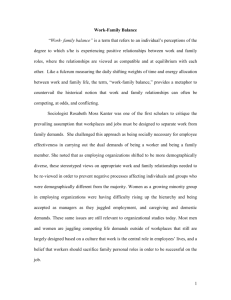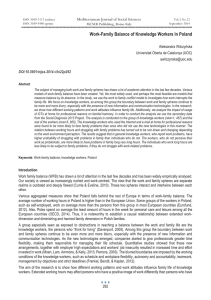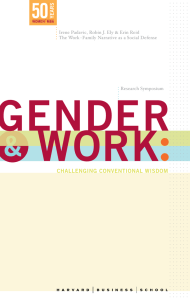Implementing Policies, Practices and Culture to Support
advertisement
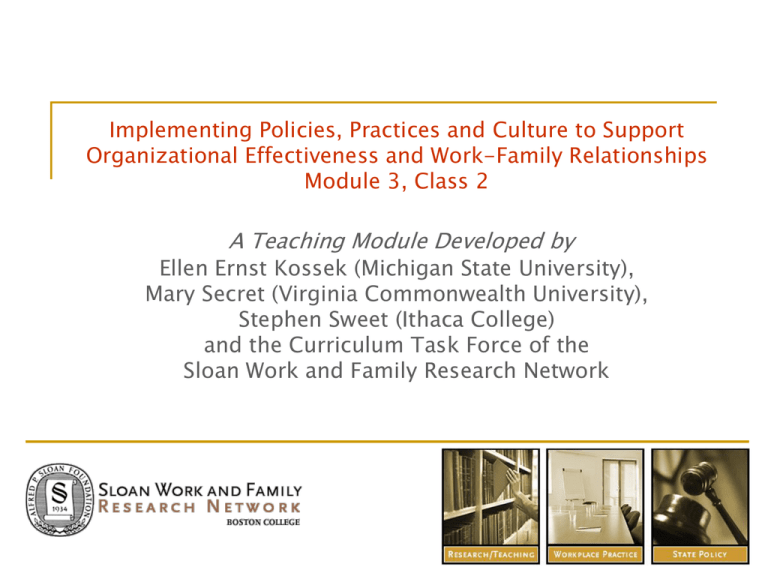
Implementing Policies, Practices and Culture to Support Organizational Effectiveness and Work-Family Relationships Module 3, Class 2 A Teaching Module Developed by Ellen Ernst Kossek (Michigan State University), Mary Secret (Virginia Commonwealth University), Stephen Sweet (Ithaca College) and the Curriculum Task Force of the Sloan Work and Family Research Network What Happens in the Home Matters at Work HOME Child Care Disruption Adult Care giving Needs WORK Marital/Family Stress Absenteeism, Tardiness Family Illness Intent to Resign Decreased Job Performance Gap Between Rhetoric and Reality Many firms have cultures where using work/life policies is seen as benefiting the individual far more than the firm. Meeting employee’s personal needs are not yet seen as meeting customers’ needs. Work/life policies are still largely programmatic minimal link to other HR policies nominal focus on informal cultural issues glass ceiling effect Managerial Concerns Labor costs Turnover Quality and customer service Absenteeism How might these vary among employers for different types of workers? How might employers in different industries have different views? Factors affecting use of work-life policies/practices 1. 2. 3. 4. 5. 6. Corporate culture Organizational approach to managing change Supervisor support Individual characteristics Job content factors Work-group factors Bureau of Labor Statistics distribution of work-life policies and programs Families and Work Institute Family-Friendly Index Flexible Work Arrangements Corporate Giving/Community Service Flextime 25 Part-time work 25 Job sharing 25 Flex-place Other flexible arrangements Subtotal Management Change Corporate giving to community/national work-family initiatives 25 15 Funds to benefit employees 25 15 Other corporate giving/community service programs 10 105 Leaves Subtotal 60 Work-family manager training 25 Work-family coordinators 15 Work-family handbooks 10 Other management change 40 Subtotal Dependent Care Services 90 Child care or family leave 25 Child care resource and referral 20 Work-Family Stress Management Other leaves 15 Elder care consultation and referral 20 Employee assistance program 10 On- or near-site child care centers 25 Wellness/health promotion 15 Consortium child care centers 20 Relocation services 10 Sick/emergency child care programs 15 Work-family seminars 10 After-school programs 15 Work-family support groups 10 Subtotal 40 Financial Assistance Flexible benefits/flexible spending accounts 25 Long-term care insurance 10 Adoption assistance 10 Summer camps 15 Work-family newsletters 10 Child care discounts 5 Caregiver fairs 5 Other work-family stress management programs 15 Vouchers 20 Other dependent care services 25 Other financial assistance 10 Subtotal 80 Subtotal 160 Subtotal 80 Total 615 Stages in Organizational Development on Work and Family Stage 1: Employer adopts a few work family policies on paper, but they are not integrated into the culture Stage 2: Many policies and practices exist for different work–life needs, work-family professionals hired Stage 3: Work family issues have strong cultural acceptance, managerial support, and work is designed with consideration for family life Making the Business Case: Strategies of Selling Management philosophies over support of worklife can vary Strategic HRM /productivity Employer of choice/ diversity views Reciprocity Trade-off Dual agenda Strategic HRM Views of Business Case What is economic performance of firms that provide work-life balance? Do the firms that provide the best work-life balance do better in the marketplace? Are they more profitable? Are employees of those firms more productive? Do these policies have a return on investment? Employer of Choice Cascio & Young 2003 study: Stock performance of Working Mother 100 Best companies consistently higher Why? 35 % of analyst’s “investment decision” is determined by non-financial information: “ability to attract & retain people” workforce is increasingly diverse; want talent of all backgrounds to want to work for you Employer of Choice View “Best employers” typically receive twice as many job applications per position as other firms. Example: Job applications received by Edward Jones & Company (named by Fortune as the #1 best employer to work for in 2002, 2003) increased from 40,000 to 400,000 after on list. Best practice: Marketing work life as best employer competency, Tradeoff View Productivity pitted against leisure Outdated traditional paradigms: Worker time for money; Work vs. family Best practice: How to redesign jobs for mutual benefits for managing work- life Reciprocity Managerial View Workers will give more discretionary performance when the employer is supportive. Example: Employees who rated work life benefits as useful were significantly more likely to make voluntary workplace improvement suggestions (Lambert, 2000). Best practice: Implementing work-family benefits that workers value. Collaborative Interactive Action Research (CIAR)*:Three Pronged Approach Dual Agenda Engagement at the workplace level Employers, employees Engagement at the associational level Unions, Professional organizations, trade associations, community groups Engagement at the state level Government officials *Bailyn, L., Bookman, A., Harrington, M. & Kochan, T. (2006). Work-family interventions and experiments: Workplaces, communities, and society. In M. Pitt-Catsouphes, E. E. Kossek, & S. Sweet (Eds.), The work and family handbook: Multi-disciplinary perspectives, methods and approaches (pp. 7399). Mahwah, N.J.: Lawrence Erlbaum Associates, Publishers Guiding assumption of CIAR: Life difficulties negatively affect work performance: Redesign for Dual Agenda Strategy Challenge assumptions that impede gender equity and work-life integration (microinterventions) Redesign work practices to integrate work with family lives and enhance work effectiveness Couple research with workplace redesign Approach Collaborate - engage workers and managers in the research process Fluid expertise Honoring resistance Feminist methodology Focus individuals on the dual agenda Develop institutionalized mechanisms for dissemination Supplemental Exercises for Additional Classes Work Life Policy Business Case Exercise Goal: Students Learn to make business case for adopting policies at their college and learn the challenges of doing so Work-Life Strategy Game Goal: Students work in teams to develop a work life strategy that fits their industry and workforce, and answer questions in a game to gain familiarity with policies, and managing work-life issues, and can buy policies that fit with their strategy Business Case Assignment Identify a work-family policy that could have an impact on business practices at your college/university Make a business case for its implementation Identify two articles on this policy as it was implemented at other workplaces. Outline the shape of the policy Who could be eligible (and who can’t be) Costs and implications (returns on investments) Outline how you would go about creating the organizational change….or if a business case can not be made your thoughts on how this issue should be addressed. ROI: Returns on Investments Cost estimates – what should be considered? Outcomes benefits – what should be considered? Does the company need loyal workers (all workers or just some? Does that influence how the policy is constructed) How is productivity measured? Hours vs quantity and quality of production Work Groups Members in each group pose the policy he/she wants to advance and then all collectively consider The types of information needed to make a business case Which of these items are “knowable” in advance? The best avenue for making a business case and selling the policy to the organization The feasibility of making this available to all workers or contingents of workers at the college. Paid Family Leaves for New Parents: Comparison between US and Europe Leave w/ Basic Pay Available to Available to Additional Incentives for Wage Provisions Mothers Fathers Unpaid or Low Fathers’ Use: Only Only Benefit Weeks Lost if Leave Father Replace (weeks) (% wages) (weeks) (weeks) (weeks) Doesn’t Use Nordic Countries Norway 52 80% 9 4 - 4 Sweden 52 80% 0 2 13 4 Denmark 30 100% 18 2 52 26 Finland 44 66% 18 3 108 - France 18 100% 16 2 156 - Luxembourg 16 100% 16 2 days 52 26 Netherlands 16 100% 16 2 days 26 13 Germany 14 100% 14 0 156 - Belgium 15 75% 15 3-4 days 26 13 Austria 16 100% 16 104 - Italy 26 80% 26 0 24 - Canada 50 55% 15 0 - - U.K. 26 90% 26 0 26 13 U.S.* 0 - 0 0 24 12 Continental Countries English-Speaking Countries
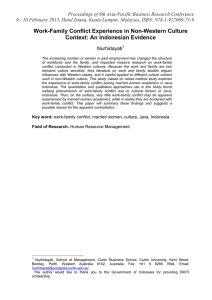
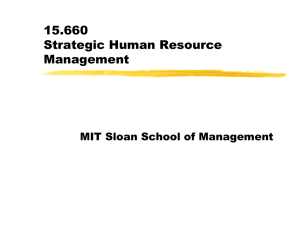
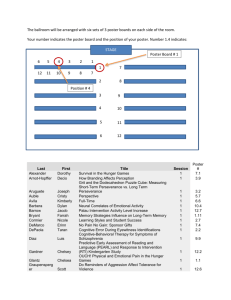

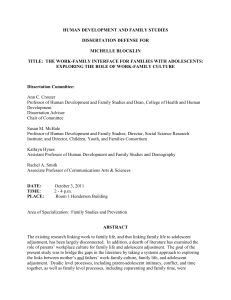
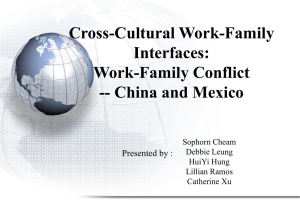
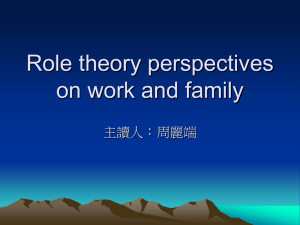

![[Edited] M. Secret review of Work and Life Integration](http://s3.studylib.net/store/data/007401433_1-93a8f56817d885815d49cb45034a65a4-300x300.png)
